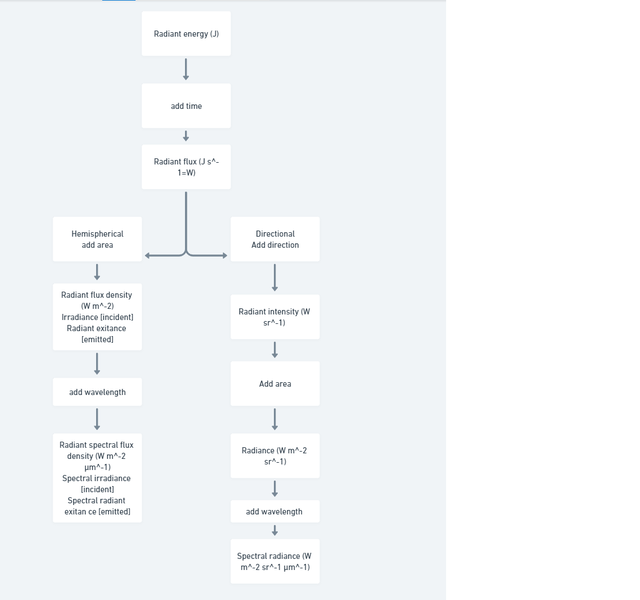Top Qs
Timeline
Chat
Perspective
Radiant flux
Measure of radiant energy over time From Wikipedia, the free encyclopedia
Remove ads
In radiometry, radiant flux or radiant power is the radiant energy emitted, reflected, transmitted, or received per unit time, and spectral flux or spectral power is the radiant flux per unit frequency or wavelength, depending on whether the spectrum is taken as a function of frequency or of wavelength. The SI unit of radiant flux is the watt (W), one joule per second (J/s), while that of spectral flux in frequency is the watt per hertz (W/Hz) and that of spectral flux in wavelength is the watt per metre (W/m)—commonly the watt per nanometre (W/nm).
This article needs additional citations for verification. (December 2009) |

Remove ads
Mathematical definitions
Radiant flux
Radiant flux, denoted Φe ('e' for "energetic", to avoid confusion with photometric quantities), is defined as[1] where
- Qe is the radiant energy passing out of a closed surface Σ in time interval T;
- t is time;
- A is the area of the surface Σ;
- S is the Poynting vector, representing the directional flow of energy per unit time, per unit area;
- n is the unit normal vector to the differential area element dA.
The rate of energy flow through the surface fluctuates at the frequency of the radiation, but radiation detectors only respond to the average rate of flow. This is represented by replacing the Poynting vector with the time average of its norm, giving where ⟨-⟩ is the time average, and α is the angle between n and S.
Spectral flux
Spectral flux in frequency, denoted Φe,ν, is defined as[1] where ν is the frequency.
Spectral flux in wavelength, denoted Φe,λ, is defined as[1] where λ is the wavelength.
Remove ads
SI radiometry units

- Standards organizations recommend that radiometric quantities should be denoted with suffix "e" (for "energetic") to avoid confusion with photometric or photon quantities.
- Alternative symbols sometimes seen: W or E for radiant energy, P or F for radiant flux, I for irradiance, W for radiant exitance.
- Spectral quantities given per unit wavelength are denoted with suffix "λ".
Remove ads
See also
References
Further reading
Wikiwand - on
Seamless Wikipedia browsing. On steroids.
Remove ads

![{\displaystyle {\begin{aligned}\Phi _{\mathrm {e} }&={\frac {dQ_{\mathrm {e} }}{dt}}\\[2pt]Q_{\mathrm {e} }&=\int _{T}\int _{\Sigma }\mathbf {S} \cdot {\hat {\mathbf {n} }}\,dAdt\end{aligned}}}](http://wikimedia.org/api/rest_v1/media/math/render/svg/eebeae5e669aa3dd16351cb0a3a3d522a88210e8)


